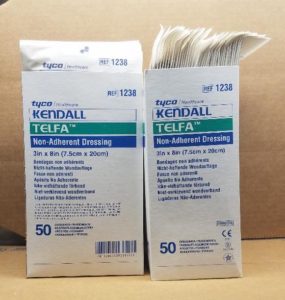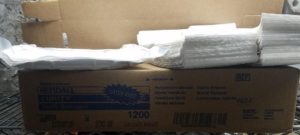So youre a somewhat serious survivalist and you’ve come to the conclusion that a few medical supplies might not be a bad idea to stash back for the day the hospitals are overwhelmed and supplies are short. Off to eBay you go. And you realize that for the price of, say, two boxes of band aids at the local supermarket you can buy an entire case of 2,500 band aids from eBay vendors. Good band aids, too…not made in China crap. Same for gauze, pads, tape, etc, etc.
And then you realize that while 2,000 packages of 4×4 gauze might be useful after the apocalypse, until that time apocalypse happens it sure takes up a lot of room.
Thats pretty much what happened to me. As I was rearranging things the other week it occurred to me that the bulkier first aid supplies took up a lot of room. Not because they were bulky on their own, necessarily…but rather because there was so much of it.
Since I had the vacuum sealer out, I figured that perhaps vacuum sealing some of these items might cut down the space they took up, in addition to providing a lovely level of protection.
How much space? Well, lets grab a couple boxes of 3×8 non-adherent dressings and check…

So there’s a full box of dressings. Fifty per. Let’s see how they stack up…
 One stack of fifty compresses down to a rather significantly smaller package.
One stack of fifty compresses down to a rather significantly smaller package.
So after a few hours I compared ‘before and after’. For example, the original box that held 18 ABD pads now held 35. That’s about a 50% savings in space and a thousand percent increase in protection from environmental factors.
The end of this long story is that I managed to clear off almost an entire shelf’s worth of supplies and compact them down to fit into one large plastic tub…and in the process add a layer of survivability to the packaging. (Everything was packaged in paper envelopes, like you get a band aid in, so there wasn’t exactly a tremendous amount of resistance to humidity, moisture, dust, dirt, etc, going on there.)
Do I ever think there’s going to be a time in my existence I need 50 rolls of rolled gauze? Man, I hope not. But once you divvy everything up between your primary location, the Beta Site, first aid kits, vehicles, etc, you can wind up going through quite a bit of stuff.
My first go-to for eBay medial stuff is these guys. After that, it’s just a matter of knowing the SKU or product number of what youre looking for and searching eBay. Oh…and having one of these.

Cdr. Zero, the vacuum sealer idea for things other than food is great, seriously. Thanks for the tip.
Yes, I use my vacuum sealer for food units, but also seal up medical as well. I even sealed bandoleers of 5.56 ammo and put two sealed bandoleers in surplus bread bag carriers so as to have covert looking re-supply units instead of ammo cans for vehicles etc. Walmart sells a cheaper cost generic knock off sealer rolls (mainstay-branding) it is a tad thinner than the food saver brand, so o.k. for non food items. But I recommend staying with the real deal for food storage.
Can you show a picture or do a post on this?
Similar advantages to the clothing type vacuum bags. They advertise the space saving qualities, which are quite substantial, but the protective factor is valuable as well; I keep a pair of wool blankets and a cheap Carhartt-knockoff winter coat in the truck, all sealed in their own clothing-type plastic “compressible” bag. Smaller space, waterproof, clear so you can see the contents, easily accessible. And, while any rational prepper already has a Food Saver (or performance equivalent*) all you need for the clothing bags is a vacuum claner with a hose attachment.
* Performance equivalent sometimes = a generic oilless vacuum pump; won’t do the “bag magic” a Food Saver will, but for canisters (and larger) it works great, and when the vac pump in your FS fails – it will eventually – a few tools and some inventive plumbing will allow using the pump as a replacement.
Does mega-compressing fabric affect it’s future performance? I’ve heard before that it can be detrimental, especially with things like blankets and jackets.
You put a couple hundred pounds of pressure on the bottom of your socks everyday. How are they performing?
Fabric doesnt seem to suffer, but it depends on the fabric I would guess. Insulation, on the other hand, is a different story. Sleeping bags, for example, are not supposed to be stored compressed because they will lose their loft. If you have a material that relies on an airy bulkiness to provide insulation, keeping it in a compressed state is probably not a great idea. But a pair of jeans and a t-shirt? Compress away!